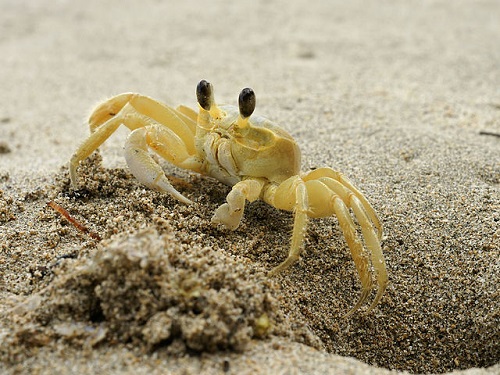Ghost Crabs live on tropical beaches
Ghost crabs are known as sand crabs
Ghost crabs are also known as sand crabs. They are tiny animals that are mainly terrestrial. They live in elaborate burrows. Sand crabs live their entire adult life on beaches in tropical and subtropical regions around the world. They prefer quiet beaches and forage for food at night when they are less apt to be seen by predators.
where Ghost crabs live
Sand crabs are found along beaches from Rhode Island south to Brazil. Unlike crabs that live in the water they only need to wet their gills. In Chesapeake Bay these crabs like to brace themselves in the sand and let the waves wash over their bodies to wet their gills. They also have hairs on the base of their legs that wicks up water from damp sand to wet their gills.

Ghost crab by a burrow entrance
What ghost crabs eat
Ghost crabs are omnivores because they eat meat and vegetable matter. They eat all kinds of food they find on the beaches. Their diet includes vegetation and other debris washed in by the tides. They also feed on mole crabs, clams and the eggs of loggerhead turtles.

Our fun science e-book contains 14 chapters and is 140 pages long. It is packed with fun information about the oceans. Each chapter contains information and an activity about life in and around the oceans. Myrna Martin

Click for More Information and to Order
Predators
Predators of these tiny crustaceans include raccoons, shorebirds and gulls. Sand crabs hide in their burrows during hot sunny days. They stay in the burrows for two reasons during the day. They stay inside their burrows during the day when the hot sun heats up the beaches. It is also much harder for predators to see the tiny crabs at night than it is during daylight hours.
Ghost crab live in burrows
Ghost crabs all live in burrows that have a small opening about the size of a nickel or a quarter. They burrow down into the sand often creating an elaborate tunnel system underground. Their tunnels often go down four feet into the sand with side branches. Young sand crabs create burrows close to the water’s edge while older adults often create burrows hundreds of feet from the edge of the waves.
mating and reproduction
Sand crabs mate all year long and the males prefer to mate near their burrow holes. During the mating time with a female the male secretes a fluid that hardens and prevents rival male’s sperm from reaching the ova of the female. The female carries the fertilized eggs under their bodies until they are ready to hatch. She releases the eggs into the water where the larvae grow and develop into young crabs before coming ashore to live the rest of their lives.
Physical Features
Ocypoda is the Latin name for ghost crabs. It means “swift-footed.” The crabs have four sets of walking legs and one pair of white claws. The adult’s carapace (shell) is usually about 2 inches long. Young crabs are much darker with a mottled gray or brown shell. Older adults have shells that are square-shaped and semi-transparent. The males are usually larger than the females and their shells can grow up to 3 inches long. They have eyestalks that are club shaped. The crabs can rotate the eyestalks 360 degrees looking for predators and food.
KIDS FUN Science Bookstore
Check out Myrna Martin's award winning textbooks, e-books, videos and rock sets. The Kids Fun Science Bookstore covers a wide range of earth science topics. Click here to browse.










